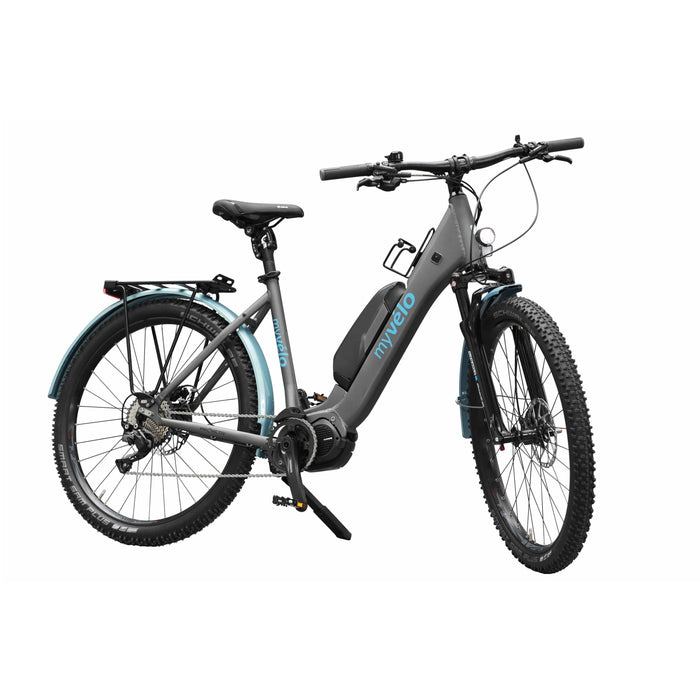
Palermo Equipped E-SUV
incl. FREE shipping & free returns

Automatic gearshift on e-bikes – does that make sense? Manual gearshift is going out of fashion: While automatic gearshifts have dominated cars for years, they are still relatively rare on bicycles – including e-bikes.
Von Fabian Huber |
6 minutes read time

What types of gear shifting are there on e-bikes and what are their characteristics? We will explain the advantages and disadvantages of the different types of gear shifting in detail. And of course there is also a short guide: Best practice when it comes to gear shifting on e-bikes! So that you are well advised when you buy your e-bike !
To get straight to the point: There is no one right gear system for an e-bike. Which gear system is right for you depends on many different factors. What do you do with your e-bike? Where do you ride, what is your riding style? The gear system has to be right for that. With an e-bike you basically have the choice between derailleur gears and hub gears , and both have advantages and disadvantages. Electronic gears and automatic gears for e-bikes are even rarer and have not been on the market for very long. These two variants promise more comfort. But what is even more important: If used correctly, they make even better use of the power of the motor. But before we get to the best way to shift gears and the tips and tricks associated with them, we at MYVELO will introduce the different types of gears and their advantages and disadvantages.
Robust, durable, most widely used: Derailleur gears are not just used on e-bikes. They generally have more gears available than with hub gears, and the gear ratio is also higher. But how exactly does a derailleur gear work?
In principle, it's very simple: the chain is transported via gears of different sizes. Derailleurs direct the chain from one gear to the next. Pinions and chainrings eventually wear out, and the chain must be cleaned and oiled regularly. If you often ride off-road (keyword mountain bikes and downhill), you should clean and oil it after every long tour. Derailleur gears are great in e-bikes because they can handle the highest torques. They are therefore also combined with powerful motors, for example in sports pedelecs, e-mountain bikes and trekking e-bikes . Derailleur gears really make sense on these e-bikes due to their properties.
The hub gear is basically installed in the hub of the wheel and has a pinion and a chainring. Because the relatively few components are sealed in the hub, there is no need to clean it after every ride: dirt simply doesn't get in. The gears are translated via a planetary gear, which means that several gears arranged in a circle rotate around a central wheel in the middle. The gear looks like planets orbiting the sun.
A hub gear is generally considered to be low-maintenance and reliable, because neither a fall nor mud or snow can do much damage to the gear system. However, the hub gear is sensitive in another area: it does not tolerate the combined power of the human and the motor so well. Powerful motors on e-bikes are therefore often throttled to 50 Nm when a hub gear is installed. This is offset by the high level of gear shifting comfort. Hub gears are often installed in city e-bikes , and this is where they have their right to exist. A hub gear can now have up to 14 gears.
Everyday and city riders generally like their hub gears because changing gears is intuitive and comfortable. You can even change gears when stationary, which is particularly useful at red lights and after sudden braking. What's particularly convenient is that you change gears using a twist grip on the handlebars. This is clear compared to derailleur gears, which are rather confusing with up to four different levers.
The gear range of the hub gear is smaller than that of the derailleur gear. For a sporty e-bike, this is clearly not enough, but for a city bike, it is more than sufficient. With a hub gear, you don't "misshift", which is definitely an advantage in fast city traffic.
The special design of the hub gear allows for stepless gear shifting. Don't get me wrong: not every hub gear is stepless! Some manufacturers design the gear system without predefined gears. You operate your gear shift using a control element on the right handlebar and simply adjust the gear ratio based on how you feel. There is no engagement because the planetary gear in the hub is not equipped with gears, but with balls. This stepless gear shifting can also handle higher torques, which is interesting for e-bikes.
Compared to conventional gear shifts, the stepless gear shift is really intuitive and allows you to concentrate fully on riding. You will always find the right gear because you simply turn the handle until the pedal resistance is right and the cadence is comfortable. The efficiency of the stepless gear shift can be up to 360 percent higher than other hub gears (depending on the model and manufacturer).
Electronic gearshifts promise greater riding comfort, greater safety and less wear and tear, and are now even installed in sports bikes. Electronic gearshifts mean that the gears are changed via servo motors rather than a Bowden system. The usual rattling, clicking and inaccurate engagement that can often be heard when changing gears is not present with electronic gearshifts. Electronic gearshifts are particularly advantageous for e-bikes because they are immediate and precise.
The gearshift is linked to the drive system's sensors. Based on the cadence, the pressure on the pedals and the speed, the system can determine whether the gear ratio is correct. If necessary, a gearshift recommendation is issued.
So you save energy, the battery saves energy and lasts longer, and the materials of the gearshift are protected overall. This in turn means that you have less stress with maintenance. The electronic gearshift should be coordinated with the e-bike's motor so that the two systems really work together harmoniously. The communication has to be right: the gearshift tells the motor when a gear change is imminent, whereupon the motor throttles down the drive power for a tiny moment and the gearshift does not take place under load. This explains the very harmonious and precise change in the gear ratio.
The automatic gearshift on the e-bike saves you from having to think about the right gear, because the system really does everything on its own. The system shifts automatically based on the previously defined cadence. The resistance when pedaling therefore does not change for you, regardless of whether you are riding uphill or downhill.
The Shimano Di2 gears are particularly clever: they select the right gear based on your data. Cadence and speed are linked, and the gear you set is based on this. However, you can manually select a different gear at any time. The system notices your intervention and takes your preferences into account when changing gears in the future.
While electronic gears are always hub gears, automatic gears are available in both a hub gear and a derailleur gear version. This explains why we first explained the advantages and disadvantages of derailleur and hub gears. Automatic gears and e-bikes go together perfectly because they not only mean maximum comfort, but also extremely gentle handling of the material.
Tip: At MYVELO you can buy E-SUV bikes with automatic transmission
An e-bike has more power than a bike without motor support - that's why you chose an e-bike. However, this strength is also a decisive factor in greater material wear. By shifting gears correctly, you can reduce wear somewhat so that the cassette, chain and pinion last longer. You can also hear high levels of wear: the unpleasant noises when shifting gears mean that the load is too high. In extreme cases, teeth on the pinion or chainring break off or the chain breaks. Bending and jumping off the chain are also signs of excessive load. With an automatic gear system, you don't need to worry too much about this. However, if you shift gears manually, you can save yourself costly and time-consuming repairs by shifting gears correctly.
E-bikes have more power, so you can really pedal with a more robust gear ratio. However, you shouldn't always use the harder gears, as this leads to high wear and tear. It's better if the cadence is a little higher, as this protects the material.
Another important point: only change gears when the bike is moving but not transferring a lot of power to the rear wheel. You should never change gears when the bike is under full load. This is especially important on inclines. Anticipating your ride means that you switch to a lower gear when the road gets a little steeper. This way you can get up the hill with ease and with little effort.
However, you must not change gears when the bike is stationary, as dry shifting can lead to drive defects. If the bike is stationary and you want to change gears before setting off, there is a trick: deactivate the motor support, reach under the saddle and lift the back of your bike. Now put one foot on the pedal and push a little, then you can change gear.